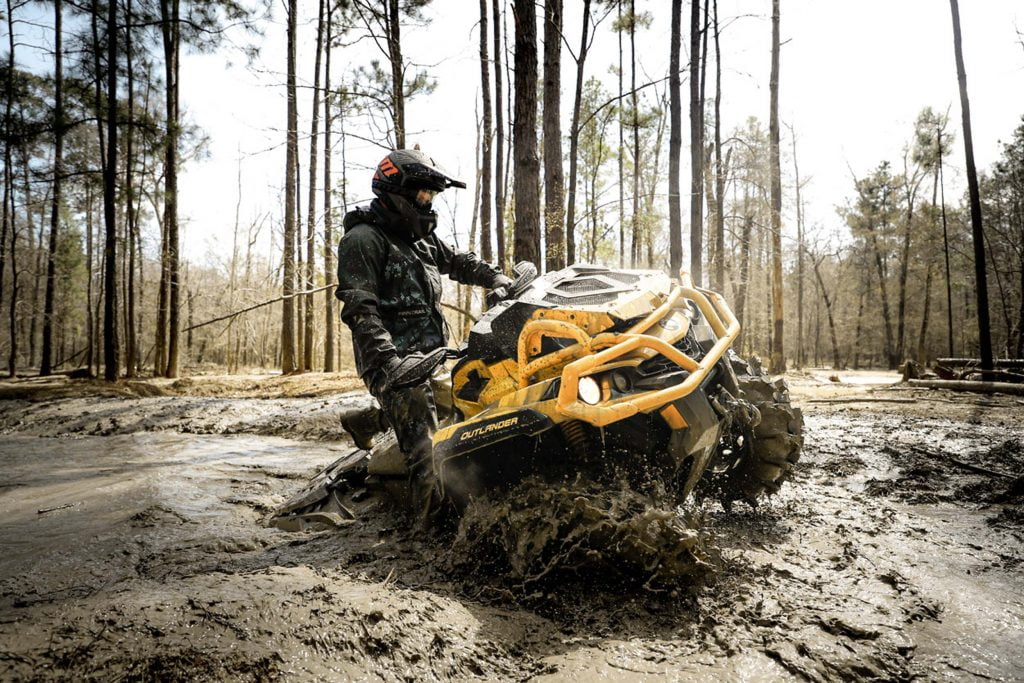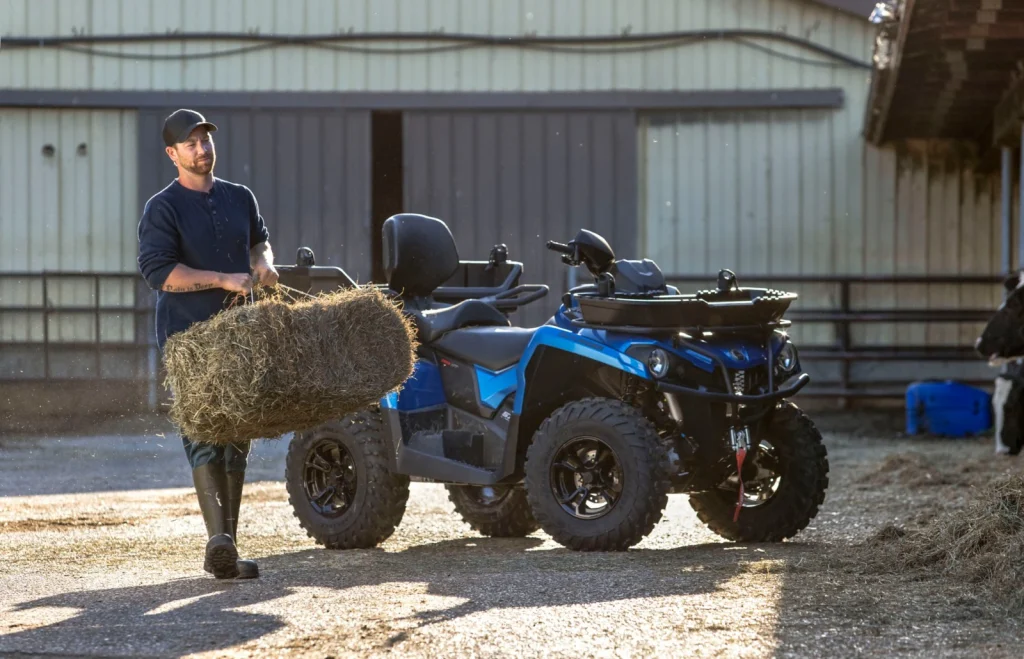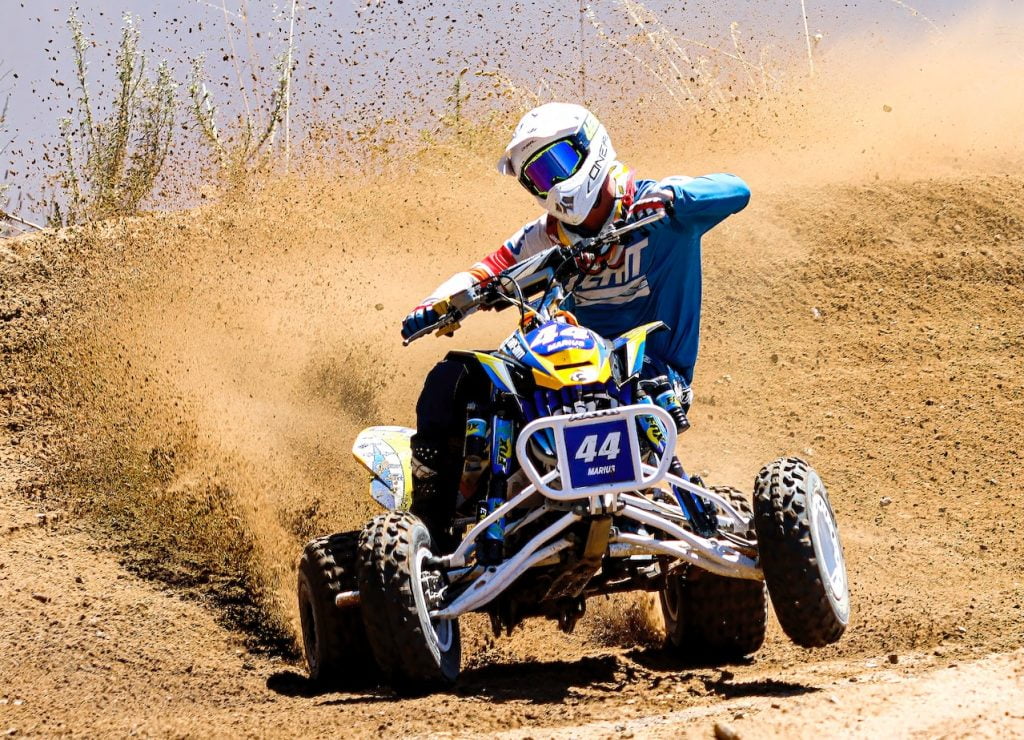If you haven’t yet tried ATV riding, you’re in for a real treat. This form of motorized activity can be exciting, relaxing, and helpful, all at the same time.
ATV riding is a form of off-road driving where the rider operates an ATV (All-Terrain Vehicle) on public trails, a closed course, forest roads, or other off-road riding applications. People typically ride ATVs for fun and recreation, work and utility tasks, or racing.
ATV riding is more prevalent in rural and countryside areas than in cities because there are more suitable locations for riding in these regions.
Related: What Is an ATV? (ATV vs Quad vs UTV vs Motorcycle)
Let’s look at what the term “ATV riding” means and the many forms of ATV riding to explore.
What Does ATV Riding Mean?
Technically speaking, you are ATV riding any time you operate an ATV, whether hauling firewood or as a means of transport out to your favorite hunting grounds. But that is typically not what people consider when they use this expression.
When someone asks you if you want to go ATV riding, they usually refer to some form of recreational ATV riding, such as organized close-course riding in groups or trail riding alone on a touring model or in a group of other ATVs.
But they could also refer to other riding forms, such as dune bashing if you live near a desert or rock crawling in the mountains.
Note that the correct term for operating an ATV is ATV riding and not ATV driving.
- Riding is when you are on top of your means of transport (horse, bicycle, motorcycle, ATV, etc.)
- Driving is when you are inside your means of transport (car, bus, train, UTV, etc.)
Related: Are ATVs Hard to Drive? Avoid These Beginner Mistakes
Different Forms of ATV Riding
One of the characteristic features of ATVs is their versatility. There is likely no other type of vehicle that can be used for so many different riding applications than ATVs.
This post will cover some of the most common forms of ATV riding. However, the riding types listed below are just the tip of the iceberg. Check out his post to read our 46 tips on ways to use your ATV.
Closed Course ATV Riding
ATV riding on closed courses is often available at adventure and activity parks. This activity can be enjoyed solo, with family, or in larger groups, such as with friends or as part of a company outing.
The riding typically happens on a closed course with guidance from trained instructors. The park provides you with an ATV, protective gear such as a helmet, and basic operating instructions.
Related: Beginner Guide: ATV Controls Explained (With Photos)
The ATVs offered are typically basic models with small to medium size engines. Some parks provide youth-size models for the kids, and others focus solely on adult riders.
There are several reasons why most activity parks do not offer higher-end ATVs with high-power output engines.
Beginner-level riders. Closed course riding is a typical arena for novice riders who do not yet have the required training and experience to operate a high-power ATV safely. Lower riding speeds significantly reduce the risk of accidents.
Less wear and maintenance. Lower riding speeds mean less strain and wear on wheels, suspension, and undercarriage components. This means less time spent making expensive repairs and more time out on the course earning money.
Lower initial purchase price. Entry-level ATVs with smaller engines are much cheaper than higher-end models.
To ride ATVs in an activity park, you typically pay for a certain amount of riding time or a specified number of laps around the track.
Closed course riding is a relatively safe form of ATV riding with a limited riding speed and an enclosed riding course.
However, keep in mind that accidents can happen even at lower speeds. One potential element of risk is when beginners ride with more experienced riders and overestimate their riding capabilities when trying to keep up.
Related: 10 Effective Tips to Prevent ATV Accidents
Recreational Trail-Riding

ATV trail riding is a popular weekend activity where people ride unpaved off-road trails for recreational purposes. You typically don’t have a specific destination; your primary goal is to enjoy the ride.
You can go alone or gather a group of friends and family. Many ATV owners buy their machines primarily with this form of riding in mind.
Trail-riding is a great way to get out and explore what nature offers, combined with the thrill and joy of riding an ATV.
Look for trails that allow motorized off-road vehicles, including ATVs. Routes are available nationwide on public and private lands. PS: Some trails have width restrictions due to narrow gates and bridges, typically 50 inches.
Some trails offer stunning views and experiences accessible only by ATV, which would otherwise require a multi-day hike to reach. One of the best things about ATVs is how they allow more people to get out and enjoy nature to the fullest.
Please note that most trails have rules and guidelines everyone must follow, such as rules against driving outside the marked trail. Ensure you read and understand these rules before you go out, as breaking them usually involves significant fines.
Some trails can be used for free, while others require payment of an entrance fee or trail pass, usually ranging from $10 to $30.
It’s becoming more common for managed trails to charge a small fee, which I think is a good thing. The money is spent to keep up with trail maintenance, build bridges, control vegetation, maintain trail marks, and so forth.
You do not need to own an ATV to go trail riding. You usually don’t have to look far to find an ATV rental shop near the more popular trail-riding destinations.
Renting an ATV for a weekend trail ride is an excellent way to experience it before committing to buying your own bike.
Rock Crawling

Rock Crawling is a form of technical off-road riding that aims to conquer particularly challenging pieces of trail with large rocks and exposed bedrock.
This type of ATV riding focuses on slow, controlled movements and selecting the best path to navigate.
Maneuvering a vehicle through a rock-crawling trail requires a high rider skill level and total concentration. Otherwise, there is an increased risk of getting high-sided on a rock or potentially tipping.
You can use almost any off-road vehicle for rock crawling; however, some are more capable.
With their lightweight design and high maneuverability, ATVs offer tons of rock-crawling fun. However, they may not be the best option for the most challenging tracks.
The narrow track width, short wheelbase, and relatively high center of gravity with the rider on top increase the risk of tipping if the terrain becomes too rough.
Mudding

Mud-bashing, or simply “mudding,” is where the rider voluntarily brings the vehicle into deep mud or muskeg pits with only one goal: to get across and back up on the dry ground.
Like rock crawling, nearly all off-road vehicles are suitable for this activity, though certain vehicle features are more desirable.
ATVs make ideal mud-bashing machines with their lightweight construction, large wheels, and high maneuverability.
Most riders that engage in this form of ATV riding modify their machines with lift kits, snorkels, and larger wheels for improved performance.
Related: 26 Essential ATV Mudding Mods
Utility Tasks

ATVs are not just for fun and play but also for great little utility machines.
Farming activities such as sowing, plowing, and tilling may not be the first thing that comes to mind when discussing ATV riding, as their primary focus is on the task rather than the actual ride.
Other utility tasks, such as hauling feed out to the pasture, inspecting a fence line, or hauling gear out to a deer stand, make for an excellent opportunity to get the job done while enjoying the ride.
Competitive ATV Racing

A high power-to-weight ratio and an active riding style that emphasizes proper body positioning for vehicle control make ATVs engaging and potent racing machines.
ATV racing is typically performed on closed-circuit tracks similar to dirt bike tracks. The track usually has an unpaved, dirt gravel or sand surface, several jumps, rapid elevation changes, and sharp turns.
Traditionally, rear-wheel drive quad bikes have been the dominant ATV type used in racing. However, in later years, 4×4 ATVs have entered the race tracks as recreational 4×4 ATVs have evolved into powerful sports vehicles.
Who Is ATV Riding For?
Recreational ATV riding is for those who enjoy the outdoors, like operating Powersports type of vehicles and are looking to add some thrill and joy to their life.
Your typical ATV rider ranges from mature riders out on relaxing Sunday trail rides to the thrill seeker seeking more extreme and challenging forms of riding.
ATV riding may not be for those who cherish quiet and comfort and dread being exposed to the elements and the outdoors.
Can Anybody Ride an ATV?
Who is legally allowed to ride an ATV depends entirely on the rules and regulations of where you want to ride.
Most states and countries have laws that regulate ATV operation by youth and children.
States or countries where ATVs are allowed on public roads typically require specific driver’s licenses.
You also have to consider things like physical capability and previous riding experience.
ATV riding is considered an active riding style where body movement and placement are essential for safe operation, particularly in rugged terrain.
People of almost any physical level can enjoy low to medium-pace trail rides on smooth forest roads. However, more technically challenging trails and off-road riding can cause fatigue or improper vehicle handling in people lacking physical strength and stamina.
Disabled people may or may not ride ATVs, depending on the nature and severity of their disability. Safe ATV riding requires two functioning arms and legs to operate vehicle controls and to keep the rider from falling off the bike.
ATV riding for Kids and Youth
In the US, ATV riding is regulated on a state level, not a federal level. The state rules vary from state to state but typically regulate factors such as:
- Riders under a given age need to wear the specified protective gear. For instance, in Florida, riders under 16 must wear protective headgear with eye protection.
- Riders under a given age can only ride under adult supervision. For instance, in Iowa, riders under 12 can only ride under the supervision of an adult with a valid license or as part of organized training.
- Physical requirements. Some states have requirements regarding how riders under a given age must be physically capable of reaching and operating the ATV controls. Age is not always the best factor in determining whether a young person can operate an ATV safely. A 12-year-old can be mature enough to ride but may have some growing to do before reaching the physical size and strength required.
- Training and certificate requirements. Some states require that riders under a certain age take a safety course to be allowed to ride an ATV.
- Maximum engine size for younger riders. Some states, such as Kentucky, New Jersey, and Virginia, prohibit riders under a specified age from operating ATVs with engines over a given engine size, typically 70cc or 90cc.
Please refer to your local laws and regulations to determine whether your child can legally operate an ATV.
Related: Choosing the best ATV for 10-year-old kids
Before allowing your child to ride an ATV, remember that an ATV is not a toy. Your job as a parent is to ensure the child is mature enough to understand the risks and potential consequences of reckless riding.
ATV Safety Institute has made this Readiness Checklist (external link). I recommend you use it to help determine whether your child is ready.
What You Need to Ride an ATV
An age-appropriate ATV. Children lack the physical size and strength to operate an adult-size ATV safely.
Permit: In some states, such as Oregon, you need an ATV operating permit to ride an ATV on land open to the public for ATV use.
Helmet and eye protection: It is recommended for ATV riders and passengers of all ages always to wear a helmet and eye protection. In some states, proper head and eye protection are required by law. Motorcycle helmets and motocross helmets are acceptable types of helmets for ATV riding.
Related: The difference between an ATV helmet and a motorcycle helmet
Protective clothing: It is recommended to wear gloves with good grip, long pants, a long-sleeved jacket, and over-the-ankle boots. This helps prevent cuts and bruises from flying debris. If rain is expected, wear waterproof clothing.
Safety course and guidance: Before operating an ATV, ensure you get adequate training and guidance to operate the vehicle safely. You can achieve this by taking an ATV training course or with guidance from a more experienced rider as a minimum.
Related Questions
Is ATV Riding Easy or Difficult?
Mastering the basics of ATV riding is quite manageable with the proper guidance. However, the difficulty level increases as the terrain becomes more challenging, like steep hills, slippery surfaces, or uneven and rocky grounds.
Is Riding Good Exercise?
Moderate-speed ATV trail riding on smooth surface roads is not too physically challenging and, therefore, not considered much exercise.
However, more technically challenging off-road riding and ATV racing can be extremely physically challenging and will most certainly improve physical strength and endurance over time.
